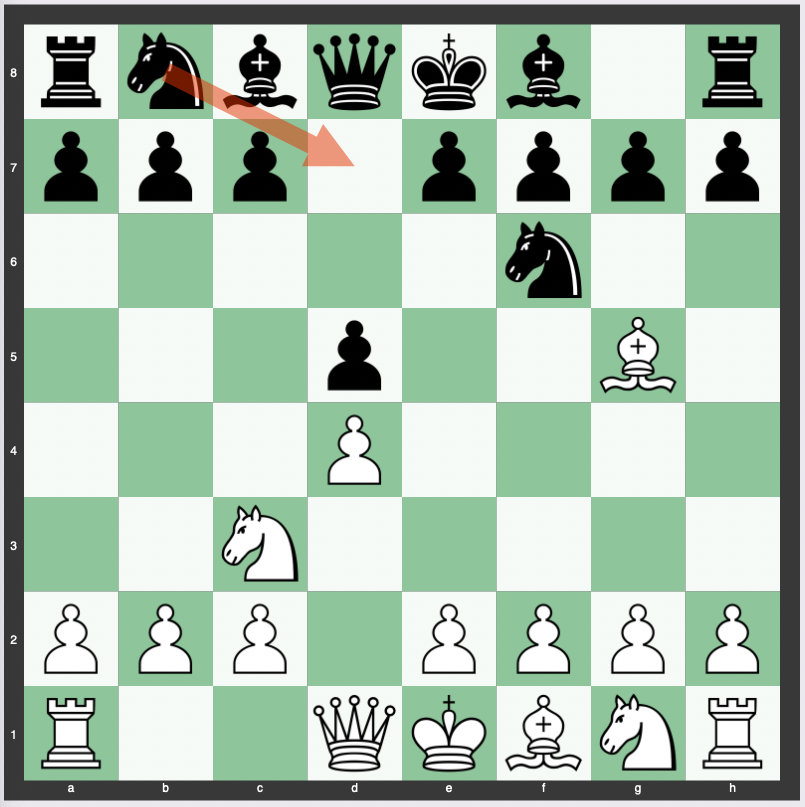The Richter-Veresov Attack is a chess opening that has intrigued enthusiasts and professionals for decades.
Beginning with a specific sequence of moves and marked by its incremental development, it can set the stage for a dynamic and strategic battle.
We look into the history, theory, variations, and usage of this opening, exploring whether it might be suitable for beginners or intermediates and how often it is employed at the grandmaster level.
Move Order of the Richter-Veresov Attack
The Richter-Veresov Attack begins with the following moves:
- d4 d5 (Closed Game)
- Nc3 Nf6
- Bg5

It can be reached by various transpositions, such as:
- d4 Nf6 2. Nc3 d5 3. Bg5
- d4 Nf6 2. Bg5 d5 3. Nc3
- Nc3 Nf6 2. d4 d5 3. Bg5
Theory, Strategy, and Purpose of the Richter-Veresov Attack
The Richter-Veresov Attack promotes rapid piece development and often resembles a king pawn opening.
With fewer pawn moves than standard queen pawn fare, it can lead to a central advance or direct assault on the enemy king.
The opening’s dynamics are quite different from the more popular Ruy Lopez opening, although they may appear similar.
Variations of the Richter-Veresov Attack
There are several key variations in the Richter-Veresov Attack:
- Richter Variation: After 3…Bf5, Richter usually continued 4.f3, intending to build a large pawn center.
- Veresov Variation: In the same position, Veresov usually played 4.Bxf6, aiming to damage the black pawn structure.
Other popular Black responses include 3…Nbd7, 3…e6, 3…c6, and 3…c5, each potentially leading to different sub-variations.
History of the Richter-Veresov Attack
The Richter-Veresov Attack dates back to the game Marshall-Wolf in Monte Carlo, 1902.
Prominent players like Savielly Tartakower, Kurt Richter, and Gavriil Veresov have contributed to the development and popularization of the opening.
Tartakower’s interpretations typically led to a closed, maneuvering game, while Richter and Veresov explored more aggressive lines.
The opening has been experimented with by grandmasters like Spassky, Tal, Smyslov, Larsen, and Bronstein and continues to see interest in contemporary play.
Is the Richter-Veresov Attack Good for Beginners or Intermediates?
While the Richter-Veresov Attack contains subtlety and depth, its focus on rapid development and the possibility for aggressive play might make it suitable for intermediates.
The variations and potential complexity might present challenges for beginners.
How Often Is the Richter-Veresov Attack Played at the Grandmaster Level?
Though never extremely popular at the top level, the Richter-Veresov Attack has been employed occasionally by grandmasters as a surprise weapon.
Notable names like David Bronstein, Héctor Rossetto, Lev Alburt, and others have used it in competitive play.
In more recent times, Grandmaster Jonny Hector and Alexander Morozevich have shown interest in this system.
Conclusion
The Richter-Veresov Attack offers a fascinating and dynamic chess opening with rich historical roots.
From its early beginnings to contemporary grandmaster play, it has offered a unique blend of strategy, variations, and surprises.
While it may not be the best fit for complete beginners, intermediate players looking for aggressive and complex play might find it an appealing choice.
Though not a mainstream choice among top players, it continues to be a noteworthy part of the chess landscape, reflecting the ongoing evolution and diversity of chess opening theory.


